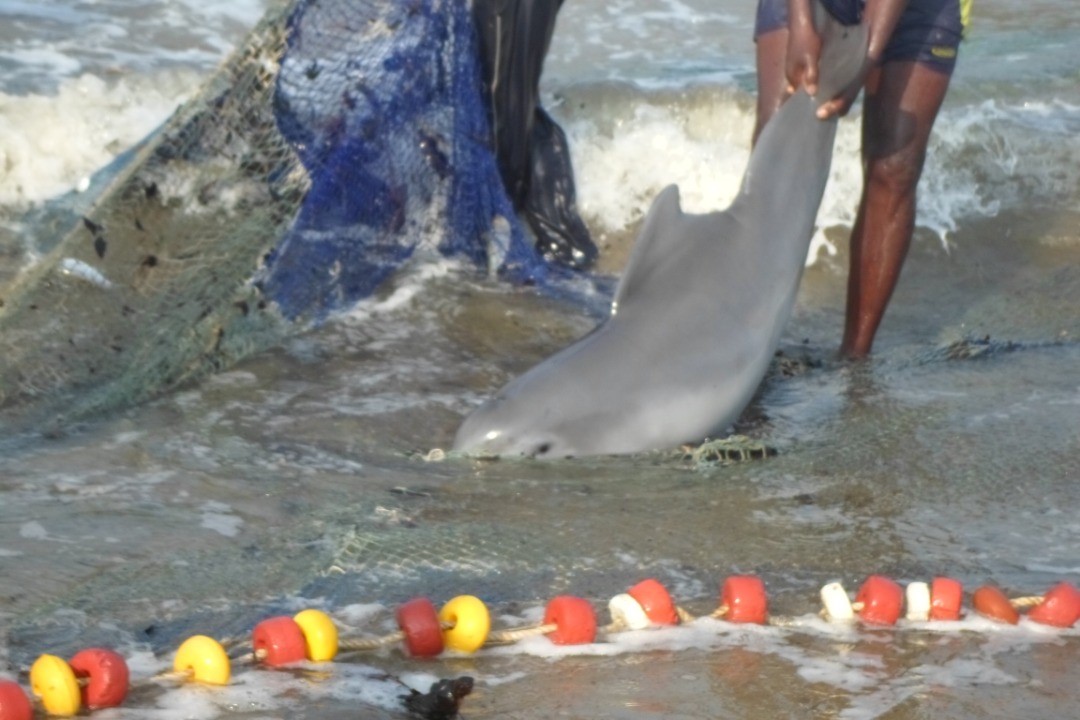Local community members play crucial role in the rescue and release of Atlantic humpback dolphins in Gabon

Juvenile Sousa teuszii being removed from a beach seine net in Cap Lopez, Gabon. Photo courtesy of Igor Akendengue.
By: Judicael Régis Kema Kema and Berthin Lembi (National Parks Agency -ANPN) Anges Marie Ngobou Ngobou (Provincial Fisheries Authority- DGPA) and Dr. Akendengue Aken Igor (Aquatic Species NGO)
On the morning of December 22nd, 2021, fishermen from the coastal community of Cap Lopez, Gabon, found more in their beach seine net than they had bargained for: Eight Critically Endangered Atlantic humpback dolphins (Sousa teuszii, AHD).
Luckily, these fishers had been working closely over the past several months with Gabon’s National Parks Agency (ANPN) and the newly created local NGO, Aquatic Species, who have been raising awareness about the threat that bycatch poses to endangered, threatened and protected (ETP) species, and local ANPN staff were on hand to help form a rescue team.
Within the first several minutes, four dolphins were able to escape the net unassisted, but four dolphins remained – 2 adults and two smaller individuals, likely to be juveniles. The net was gently pulled closer into shore where the rescue team could work more easily to free them. While one dolphin used its strength to break through the net and escape, fishermen, ANPN Ecoguards and staff from the Aquatic Species NGO worked together to grab the other three by the tail stock, and pull them to deeper waters beyond the net. Following their release, all four animals appeared fit enough to be able re-join the other four dolphins that had escaped. It is hoped that the rescued individuals have not suffered any lasting physical trauma, and will be able to thrive. Earlier that same morning a separate group of 12 AHD had been observed to the north of Cap Lopez.
The quick-thinking fishermen and park staff are commended for their decisive action, which seems to have saved the lives of four dolphins of a Critically Endangered species for which every single individual counts. The rescue is also evidence that the awareness raising and capacity building work conducted by the ANPN and Aquatic Species is having a positive impact for the species. This work followed on from a successful government stakeholder engagement meeting hosted by the Ministry of Water and Forests’ ‘Direction Générale des Ecosystèmes Aquatiques’ and supported by CCAHD Steering Committee member and ANPN employe, Judicael Regis Kema Kema. The meeting recommended closer collaboration between fishing communities, government agencies, and NGOs, to reduce threats to AHD. This incident is a perfect example of that collaboration in action.
At the same time, there are also some lessons that can be learned from the event:
- The incident confirms that beach seine nets present a serious threat to coastal species like AHD. However, in areas of open coastline where it is often unsafe to launch and recover boats and fish further offshore, it is easy to understand why this relatively safe and inexpensive method is used. The ANPN and the Fisheries Agency (DGPA) have started a gear conversion programme encourage fishers to shift to other methods with less risk of bycatch. However, more funding is required to subsidise the new gear and carry out scientifically robust monitoring to ensure the programme’s effectiveness. In the meantime, the ANPN and DGPA have reached a temporary agreement with fishers to ensure that: 1) fishers reduce the use of beach seines from 7 to 3 days per week; 2) that ANPN or fisheries agents are present to observe each haul; and 3) that all ETP species are released. It is hoped that these measures will reduce ETP bycatch as much as possible until the necessary funds are raised to implement the gear replacement programme and beach seines can be confiscated and destroyed.
- While the team reacted quickly to successfully release the dolphins from the net, there are guidelines that could have been followed that might have protected the dolphins even better from potential injury or discomfort (for example, keeping the animals in depths where they could float, and cradling them in the water to move them rather than pulling them by their tail stocks). These guidelines could be translated into French, and used in capacity building workshops with local fishing communities.

